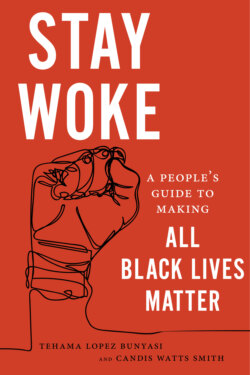Читать книгу Stay Woke - Candis Watts Smith - Страница 9
На сайте Литреса книга снята с продажи.
Some Uncomfortable Facts
ОглавлениеThe twenty-first-century Movement for Black Lives began to stir in 2013 after a jury acquitted George Zimmerman of the murder of Trayvon Martin. In reaction to the acquittal, Alicia Garza wrote a love letter to Black people, and she ended the letter by writing, “Black people. I love you. I love us. We matter. Our lives Matter.” Patrisse Cullors, her friend, put a hashtag on it, and Opal Tometi helped to build a network of folks who wanted to unite under that message: #BlackLivesMatter.
The Black Lives Matter (BLM) movement has become known as one that is primarily concerned with police brutality, but it is actually one that is broadly concerned with raising awareness of ongoing racial disparities, developing empathy for Black life, and ending anti-Black racism. Since the development of the hashtag, many other organizations have joined to develop a united front under the moniker the Movement for Black Lives (M4BL)—which consists of about four dozen local and national organizations such as the Black Youth Project 100, Mothers Against Police Brutality, the National Conference of Black Lawyers, and BLM as well. While the focus of these organizations is on Black lives, the founders of the BLM movement assert, “when Black people get free, everybody gets free.”12
AVERAGES, ANECDOTES, AND OUTLIERS
As social scientists, we aim to paint portraits of society that are not as detailed as Kehinde Wiley’s but also not as interpretive as Jackson Pollock’s. In order to find a happy medium, we rely on “averages,” central tendencies, or what is “most common.” We might use words like “many” or “most” almost synonymously with “on average.” Average describes what you are most likely to see in this world.
Sometimes, you will read something, and think, “That cannot be true because I once knew a guy who . . .” This is an anecdote. An anecdote relies on one case, perhaps illustrative, but it does not carry the weight of an average. “Averages” rely on many, sometimes hundreds, thousands, or even millions of cases. We rely on data from large opinion polls, nationally representative surveys, peer-reviewed journals and books, and even the US Census Bureau to make claims throughout this book. We provide facts rooted in data.
Sometimes, you will read something and think, “This cannot be true because Obama was elected . . . twice!” Yes, Obama, Oprah, LeBron James, and Beyoncé are phenomenal. But they are what we call outliers. These people represent exceptions to the rule and do not represent the average, everyday person. Some people achieve beyond our wildest dreams, but many people do not or cannot because of compounding inequality. In other words, there are other people who can do what these people can do, but most of us cannot and do not because we are average.
Most Americans agree that racism still exists in the United States, but many people have a narrow understanding of what racism is. This makes sense. There are various interests involved in making a particular definition of racism dominant. For example, the leaders and participants of the civil rights movement made an effort to define racism as systemic and institutional, but the Nixon administration only a few years later was able to narrow this definition to one of overt intention to discriminate on the basis of race.13 While there is some overlap between the two conceptualizations, two individuals each relying on a different definition of racism will probably never come to a shared conclusion about how to eradicate racism and its progeny. Being cognizant of the cacophony of definitions of racism with which Americans are faced helps us, as educators, to realize how difficult it is for students of antiracism to separate misinformation and disinformation from an otherwise-complex reality.
Typically, when people think of racism, they think of Jim Crow, lynchings, police with dogs, the N-word, and other overt behaviors and attitudes.14 That is an accurate depiction of a type of racism, but racism also exists in other, more covert and enduring forms, which we call structural racism. Structural racism refers to the fact that political, economic, social, and even psychological benefits are disproportionately provided to some racial groups while disadvantages are doled out to other racial groups in a systematic way. In the United States, this has resulted in white Americans having greater political, economic, social, and psychological benefits, on average, while people of color have more political, economic, social, and psychological disadvantages, on average. Nobody needs to do anything with bad intentions for structural racism to persist, but people across racial groups can intentionally or unintentionally assist in perpetuating racial inequalities. The thing about structural racism is that it is embedded in our everyday affairs, making it difficult to see if you do not know what you are looking for. Consequently, it is unclear to some people why such a Movement for Black Lives needs to exist.
In the remainder of this chapter, we provide a slew of data that illuminates the ways in which Black citizens find themselves at risk in various domains of life in the United States. We start with the most contentious: policing and the criminal justice system. Then we move to highlight racial disparities in more mundane areas of our lives: housing, education, wealth, health, and employment. We hope that by presenting the evidence across various areas of society, the fact that Black lives are consistently marginalized becomes clearer.
—
